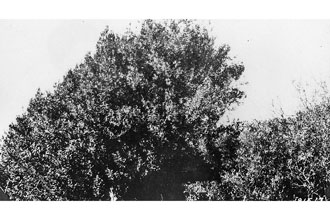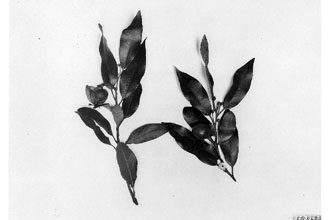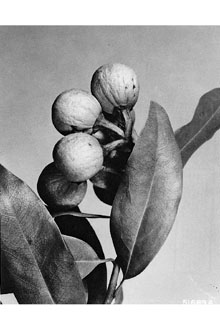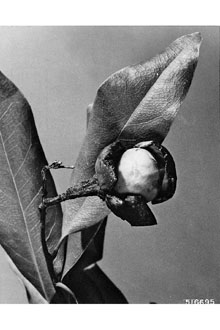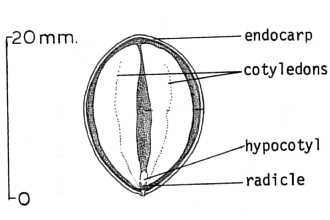California Laurel
Scientific Name: Umbellularia californica (Hook. & Arn.) Nutt.
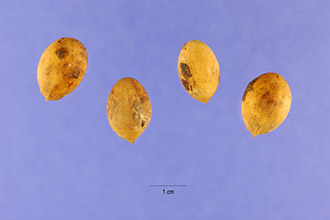
| General Information | |
|---|---|
| Usda Symbol | UMCA |
| Group | Dicot |
| Life Cycle | Perennial |
| Growth Habits | ShrubTree, |
| Native Locations | UMCA |
Plant Guide
Alternate Names
Balm of heaven, bay, bay laurel, cajeput, California bay, California olive, cinnamon bush, laurel, mountain laurel, myrtle, Oregon myrtle, peppernut tree, pepperwood, sassafras laurel, spicebush, spice-tree; two varieties are recognized, A. c. var. californica and A. c. var. fresnensis.
Uses
Ethnobotanic: The Cahuilla, Chumash, Pomo, Miwok, Yuki, and Salinan are among the California tribes that value California laurel trees for its many uses. All parts of the plant, but especially the leaves, contain an aromatic camphor-like volatile oil that has cooling, irritant, insecticidal and germicidal qualities (Chestnut 1902). Laurel leaves were tucked into and under hats or into headbands made of laurel twigs to relieve headaches (Barrett & Gifford 1933). The Salinan tribe treated sudden fits and probably headaches by making a headband of the aromatic laurel leaves (Heinsen 1972). The Catholic Fathers at Mission San Antonio de Padua, borrowing from Salinan medicinal practices, made a hot poultice of laurel leaves mixed with nutmeg, cinnamon, and olive oil, which was repeatedly applied to the head of persons suffering fits until they regained consciousness. The Kashaya Pomo made a poultice of laurel leaves that was used to treat rheumatism and neuralgia (Goodrich et al. 1980). The Pomo and Yuki tribes of Mendocino County treated headaches by placing a single leaf in the nostril or bathing the head with a laurel leaf infusion (Chestnut 1902). © R.A. Seelig @ PLANTS Laurel leaf tea was drunk to treat stomachaches, colds, sore throats, and to clear up mucus in the lungs (Chestnut 1902, Goodrich et al. 1980, Timbrook 1990). The leaves were steeped in hot water to make an infusion that was used to wash sores (Goodrich et al. 1980). Laurel leaves were steeped in baths for rheumatic patients. Infusions of the leaves were used to rid the head of lice. Leaves and branches were placed around the yard to discourage fleas. Both the flesh and the inner kernel of the olive-like fruit were used as food. The fruits were sun dried until the fleshy outer part had split and loosened from the pit (Goodrich et al. 1980). The dried flesh was removed from the seeds ready to eat. Only the bottom third of the outer dried fruit was eaten as the upper, thinner part contains a higher concentration of the acrid oil that is a component of all parts of the tree (Chestnut 1902). The seeds were roasted until they were crisp and brown (Goodrich et al. 1980). The roasting removes much of the pungency and leaves just a hint of acridity and gives the roasted nuts a spicy or coffee-like flavor. The parched nuts are then shelled and either eaten whole or pounded into a meal. The oily meal is easily pressed into small cakes that are then sun-dried and stored for use in the winter. Both the nuts and the cakes were served with clover, seaweed, buckeye meal, or acorn meal and mush. The roasted seeds were eaten as an accompaniment with clover in order to prevent bloating (Murphey 1959). The seed meal was also made into a beverage that tasted “like chocolate” (Kelly 1978). California laurel was an important ceremonial plant for the Kashaya Pomo (Goodrich et al. 1980). Branches were placed around the house to protect households against harm. Chumash hunters burned laurel leaves to attract and stupefy deer (Timbrook 1990). Wildlife: Black-tailed deer browse on the leaves and twigs, which are high in protein (Howard 1992). Birds, squirrels, and other small mammals eat the seeds. Wild pigs eat the seeds and the roots. The trees provide valuable cover for deer, black bear, wild pigs, game birds, and songbirds. Conservation: California laurel has been used to restore wildlife habitat, riparian vegetation, and flood controls (Howard 1992). Wood products: California laurel is a high quality wood that is used for cabinetry, furniture, paneling, and interior trim. Other: California laurel leaves are used as a more robust seasoning substitute for sweet bay leaves (Laurus nobilis) in cooking.
Status
Please consult the PLANTS Web site and your State Department of Natural Resources for this plant’s current status (e.g. threatened or endangered species, state noxious status, and wetland indicator values).
Description
General: Laurel family (Lauraceae), California laurel is a perennial, evergreen tree or shrub that is native to California and southern Oregon, The trees have many slender erect branches and a dense crown that can be rounded to pyramidal in shape, The height is variable depending on conditions and the plants can grow from 3 to 45 meters tall, The smallest forms are found under dry conditions and they reach their greatest size on deep alluvial soils near rivers, The greenish to reddish brown bark, which is thin and smooth on young trees, begins to peel and shed as the trees mature, The alternately arranged leaves are oblong to lance-shaped (2,5 to 11 cm long and 1,5 to 3 cm wide), Leaves are glossy dark yellow-green, thick, and leathery, When crushed, the leaves give off a strong peppery menthol-like odor, which is the reason the early European settlers gave the tree the name pepperwood, The small yellow-green flowers are borne in clusters of 6 to 10 flowers, The round olive-like fruits (1 to 2,5cm in diameter) turn from green to deep brown-purple, Inside the fruit is a single large seed, which is a white kernel surrounded by a light brown shell, Distribution: California laurel is distributed from San Diego County to Northwestern California and into southwestern Oregon, In California, it occurs in both the Coast Ranges and Sierra Nevada, Use soil moisture sensors to measure the soil moisture of California Laurel., For current distribution, please consult the Plant Profile page for this species on the PLANTS Web site, Habitat: California laurel trees are abundant near water sources in alluvial flood plains as well as shady hillsides and canyons below 1600 meters, The trees occur in oak woodlands, mixed evergreen forest, redwood forest, and chaparral, In chaparral communities they grow in canyons, valleys, and sometimes in high rocky areas were they are able tap into moisture,
Adaptation
1999 Beatrice F. Howitt © California Academy of Sciences @ Calflora California bay can regenerate after fires of light to moderate intensity (Howard 1992). The trees can sprout from the root crown and seed germination may increase following fires.
Establishment
California laurel is a versatile, medium to fast growing tree that can be used for specimen, hedge, and container plantings. California laurel tolerates a wide range of conditions and does well in full sun to deep shade. The trees grow fastest and tallest in deep, fertile soils that are well drained, with regular water availability. California laurel trees can tolerate dry conditions but are known to dieback during droughts (Labadie 1978). California laurel is propagated from fresh seeds. Seeds can be collected from October to December (Mirov & Kraebel 1939). The seeds are mature when they are dark brown and the fruits are dark purple (Young 2001). Labadie (1978) suggests lightly cracking the seeds before planting to increase germination. Hildreth & Johnson (1976) recommend 90-120 days of cold stratification for best germination. To do this, mix the seeds with 3 parts of loose soil or a mixture of equal parts peat moss and perlite. Lightly moisten the mixture and place it into a plastic bag that can be tightly sealed. Place the bag in a refrigerator kept at 30-42°F and examine them periodically for signs of germination. The seeds generally take around 93 days to germinate. If any of the seeds begin to germinate, plant them immediately keeping in mind that the primary root is first to emerge from the seed. The seeds may be planted directly into 4x4x14 inch containers filled with a standard potting mix of peat moss, fir bark, perlite and sand (Young 2001). Transplant container grown seedlings when they are under 1 year old if possible.
Management
Young trees can be trained to form a single trunk by pruning the suckers as they appear (Labadie 1978). Mature trees can be thinned to reduce the deep shading that their dense canopies can produce. Although evergreen, the trees drop an abundance of leaves, especially in the autumn.
Pests and Potential Problems
California laurel is relatively free of insect pests but can be affected by aphids, greedy scale, ivy scale, soft brown scale, thrups, white fly, laurel white fly, leaf blotch miner, and inconspicuous white fly (Labadie 1978). Heart rot, caused by the fungus Ganoderma applanatum can be controlled by cutting down infected trees to a height of 20cm and allowing them to stump sprout (Howard 1992). Cultivars, Improved, and Selected Materials (and area of origin) California laurel trees are readily available from commercial nurseries. There is a variety, U. californica var. fresnensis, which occurs in Fresno County, California (Howard 1992). Contact your local Natural Resources Conservation Service (formerly Soil Conservation Service) office for more information. Look in the phone book under ”United States Government.” The Natural Resources Conservation Service will be listed under the subheading “Department of Agriculture.”
References
Barrett, S.A. & E.W. Gifford 1933. Miwok material culture: Indian life of the Yosemite region. Bulletin of Milwaukee Public Museum Vol. 2, No. 4. Yosemite Association, Yosemite National Park, California. 388 pp. Brenzel, K.N., Editor 2001. Western garden book. Sunset Publishing Corp., Menlo Park, California. 768 pp. Chestnut, V.K. 1902. Plants used by the Indians of Mendocino County, California. Contributions from the U.S. National Herbarium Vol. VII. Reprinted 1974 by Mendocino County Historical Society. 422 pp. Emery, D.E. 1988. Seed propagation of native California plants. Santa Barbara Botanic Garden, Santa Barbara, California. 115 pp. Goodrich, J., C. Lawson & V.P. Lawson 1980. Kashaya Pomo Plants. Heyday Books, Berkeley, California. 171 pp. Heinsen, V. 1972. Mission San Antonio de Padua Herbs: Medicinal herbs of early days. Third edition. Lockwood. California. 142 pp. Hildreth, W.R. & S. R. Johnson 1976. Seed propagation at the Saratoga Horticultural Foundation. Pacific Horticulture Vol. 37, No. 4. Pp. 49-57. Howard, J.L. 1992. Umbellularia californica. U.S. Department of Agriculture, Forest Service, Rocky Mountain Research Station, Fire Sciences Laboratory (2002, February). Fire Effects Information System, [Online]. Available: http://www.fs.fed.us/database/feis/ [22 February 2002]. Jepson, W. L. 1911. A flora of western middle California. Second Edition. Cunningham, Curtiss & Welch, San Francisco, California. 515 pp. Kelly, I. 1978. Coast Miwok in Handbook of North American Indians, Vol. 8, California, R.F. Heizer, Ed. Smithsonian Institution, Washington, D.C. Pp 414-425. Labadie, E.L. 1978. Native plants for use in the California landscape. Sierra City Press, Sierra City, California. 248 pp. Mirov, N.T. & C.J. Kraebel. 1939. Collecting and handling seeds of wild plants. Civilian
Conservation
Corps Forestry Publication No. 5. US. Government Printing Office, Washington, D.C. 42 pp. Moerman, D.E. 1998 Native American ethnobotany. Timber Press, Portland, Oregon. 927 pp. Moerman, D.E. 1999. Native American
Plant Traits
Growth Requirements
| Temperature, Minimum (°F) | -13 |
|---|---|
| Adapted to Coarse Textured Soils | Yes |
| Adapted to Fine Textured Soils | Yes |
| Adapted to Medium Textured Soils | Yes |
| Anaerobic Tolerance | None |
| CaCO3 Tolerance | None |
| Cold Stratification Required | No |
| Drought Tolerance | Low |
| Fertility Requirement | Medium |
| Fire Tolerance | Medium |
| Frost Free Days, Minimum | 140 |
| Hedge Tolerance | Medium |
| Moisture Use | High |
| pH, Maximum | 7.4 |
| pH, Minimum | 5.7 |
| Planting Density per Acre, Maxim | 800 |
| Planting Density per Acre, Minim | 300 |
| Precipitation, Maximum | 84 |
| Precipitation, Minimum | 13 |
| Root Depth, Minimum (inches) | 16 |
| Salinity Tolerance | None |
| Shade Tolerance | Tolerant |
Morphology/Physiology
| Bloat | None |
|---|---|
| Toxicity | Slight |
| Resprout Ability | Yes |
| Shape and Orientation | Erect |
| Active Growth Period | Spring, Summer, Fall |
| C:N Ratio | High |
| Coppice Potential | Yes |
| Fall Conspicuous | Yes |
| Fire Resistant | No |
| Flower Color | Yellow |
| Flower Conspicuous | Yes |
| Foliage Color | Green |
| Foliage Porosity Summer | Dense |
| Foliage Porosity Winter | Dense |
| Foliage Texture | Coarse |
| Fruit/Seed Conspicuous | Yes |
| Nitrogen Fixation | None |
| Low Growing Grass | No |
| Lifespan | Long |
| Leaf Retention | Yes |
| Known Allelopath | Yes |
| Height, Mature (feet) | 80.0 |
| Height at 20 Years, Maximum (fee | 30 |
| Growth Rate | Moderate |
| Growth Form | Single Stem |
| Fruit/Seed Color | Yellow |
Reproduction
| Vegetative Spread Rate | None |
|---|---|
| Small Grain | No |
| Seedling Vigor | Medium |
| Seed Spread Rate | Slow |
| Seed per Pound | 300 |
| Fruit/Seed Persistence | Yes |
| Propagated by Tubers | No |
| Propagated by Sprigs | No |
| Propagated by Sod | No |
| Propagated by Seed | Yes |
| Propagated by Corm | No |
| Propagated by Cuttings | Yes |
| Bloom Period | Spring |
| Commercial Availability | Routinely Available |
| Fruit/Seed Abundance | High |
| Fruit/Seed Period Begin | Spring |
| Fruit/Seed Period End | Summer |
| Propagated by Bare Root | Yes |
| Propagated by Bulb | No |
| Propagated by Container | Yes |
Suitability/Use
| Veneer Product | Yes |
|---|---|
| Pulpwood Product | No |
| Protein Potential | Low |
| Post Product | No |
| Palatable Human | Yes |
| Palatable Graze Animal | Low |
| Palatable Browse Animal | Medium |
| Nursery Stock Product | Yes |
| Naval Store Product | Yes |
| Lumber Product | Yes |
| Fuelwood Product | High |
| Fodder Product | No |
| Christmas Tree Product | No |
| Berry/Nut/Seed Product | No |

